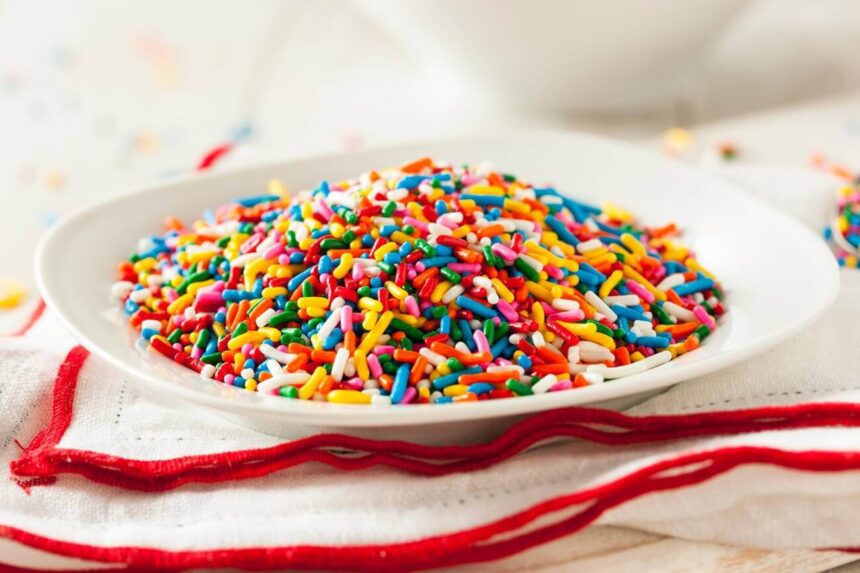Ever caught your cat eyeing your dessert, especially those brightly colored sprinkles atop a cupcake or cookie? It’s a common sight in households with curious cats. They seem fascinated by the vibrant colors and shiny bits. But the big question arises: Can cats eat sprinkles? Let’s dive into the nitty-gritty of this tantalizing topic and discover if those sugary decorations are a purr-fect treat or a potential no-go for our feline friends.
What Are Sprinkles Made Of?
Sprinkles, those tiny, colorful, and sweet decorations, might seem harmless. However, their ingredient list might surprise you. Typically, sprinkles are made of:
- Sugar: The main component. It gives sprinkles their sweet taste.
- Corn syrup: Adds sweetness and helps in binding.
- Food coloring: Gives sprinkles their bright and appealing colors.
- Wax or shellac: Provides a shiny finish.
- Cornstarch: Prevents clumping and helps in maintaining shape.
While these ingredients are generally safe for humans, they might not be ideal for cats. Our feline friends have different dietary needs and tolerances. So, let’s break it down.
Sugar and Cats: A Not-So-Sweet Combination
Cats are obligate carnivores. This means their diet primarily consists of meat. Unlike humans or even dogs, cats don’t need sugar in their diet. In fact, their taste buds are not designed to detect sweetness. So, when it comes to sugar:
- Digestive issues: Cats’ digestive systems aren’t equipped to process large amounts of sugar. Consuming sugary treats like sprinkles can lead to stomach upset, diarrhea, and vomiting.
- Obesity: Just like in humans, too much sugar can contribute to weight gain and obesity in cats. This can lead to other health problems, such as diabetes and joint issues.
- Dental problems: Sugar can promote the growth of bacteria in your cat’s mouth, leading to dental problems like tooth decay and gum disease.
In short, while sugar isn’t toxic to cats, it’s not beneficial either. Feeding your cat sugary foods, including sprinkles, should be avoided.
Food Coloring: A Rainbow of Risks?
Food coloring adds that pop of color to sprinkles, making them so visually appealing. However, not all food colorings are created equal. Here’s what you need to know:
- Artificial dyes: Many sprinkles use synthetic dyes like Red 40, Yellow 5, and Blue 1. These dyes have been linked to hyperactivity and allergic reactions in some animals. Although there’s no conclusive evidence that these dyes are harmful to cats, it’s better to err on the side of caution.
- Natural dyes: Some sprinkles use natural coloring agents like beet juice, turmeric, or spirulina. These are generally safer, but still, their necessity in a cat’s diet is questionable.
Overall, while the occasional lick of food coloring might not harm your cat, it’s not something you want to include regularly in their diet.
Corn Syrup and Cornstarch: Unnecessary Additives
Corn syrup and cornstarch are common in many processed foods, including sprinkles. However, these ingredients offer no nutritional value to cats:
- Corn syrup: Another form of sugar, which we’ve already established is unnecessary for cats.
- Cornstarch: While not harmful, it is an unnecessary carbohydrate in a cat’s diet, which should be rich in protein and fat instead.
Feeding your cat foods with corn syrup or cornstarch can lead to the same issues as sugar, including digestive upset and weight gain.
Wax or Shellac: Shiny but Not So Fine
The glossy sheen on sprinkles comes from wax or shellac. These substances, while safe for human consumption, can be problematic for cats:
- Digestive issues: Cats can struggle to digest wax, potentially leading to gastrointestinal blockages or discomfort.
- Allergic reactions: Though rare, some cats might have allergic reactions to these substances, manifesting as itching, swelling, or other symptoms.
So, Can Cats Eat Sprinkles?
Given the ingredients in sprinkles, it’s clear they’re not suitable for cats. While a few sprinkles likely won’t cause serious harm, they’re not a healthy or necessary part of your cat’s diet. The occasional accident where your cat manages to lick a few sprinkles off a cupcake shouldn’t be cause for panic. However, it’s best to keep these sugary, colorful treats out of their reach.
What If Your Cat Eats Sprinkles?
If your cat does manage to snag some sprinkles, here’s what you should do:
- Monitor for symptoms: Watch for any signs of digestive upset, such as vomiting, diarrhea, or lack of appetite.
- Check for allergies: Look out for any unusual behaviors or symptoms like itching, swelling, or excessive grooming, which might indicate an allergic reaction.
- Consult your vet: If your cat shows any concerning symptoms or if you’re unsure about the quantity they consumed, it’s best to consult your veterinarian for advice.
Healthy Alternatives: Treats Your Cat Will Love
Instead of sprinkles, consider these cat-friendly treats:
- Cooked meat: Small pieces of cooked chicken, turkey, or beef make excellent treats for cats. Ensure there are no seasonings or bones.
- Catnip: Many cats go wild for catnip, which can be sprinkled on their toys or scratching posts.
- Commercial cat treats: There are many healthy, vet-approved cat treats available that are formulated to meet your cat’s nutritional needs.
DIY Cat Treats: Fun and Healthy Recipes
If you’re feeling creative, you can make your own cat treats at home. Here are a couple of simple recipes:
Tuna Treats
Ingredients:
- 1 can of tuna in water, drained
- 1 cup of oat flour
- 1 egg
Instructions:
- Preheat your oven to 350°F.
- Mix all ingredients in a bowl until well combined.
- Roll the mixture into small balls and place them on a baking sheet.
- Flatten each ball slightly with a fork.
- Bake for 10–12 minutes, until firm and lightly browned.
- Let cool before serving to your cat.
Chicken Bites
Ingredients:
- 1 cup of cooked chicken, finely chopped
- 1/2 cup of rice flour
- 1 egg
Instructions:
- Preheat your oven to 350°F.
- Mix all ingredients in a bowl until well combined.
- Roll the mixture into small balls and place them on a baking sheet.
- Flatten each ball slightly with a fork.
- Bake for 12–15 minutes, until firm and lightly browned.
- Let cool before serving to your cat.
FAQs About Cats and Sprinkles
Are sprinkles toxic to cats?
Sprinkles are not inherently toxic to cats, but they are not suitable for them either. The sugar, artificial dyes, and other additives can cause digestive issues and other health problems if consumed in significant quantities.
What should I do if my cat eats a lot of sprinkles?
If your cat consumes a large amount of sprinkles, monitor them closely for signs of distress such as vomiting, diarrhea, or lethargy. Contact your veterinarian immediately if any concerning symptoms appear. It’s always better to err on the side of caution when it comes to your pet’s health.
Can sprinkles cause long-term health issues in cats?
Regular consumption of sugary treats like sprinkles can lead to long-term health problems in cats, including obesity, diabetes, and dental issues. It’s best to avoid giving them to your cat entirely.
Are there any safe alternatives to sprinkles for cats?
Yes, there are many safe alternatives to sprinkles for cats. You can treat your cat with small pieces of cooked meat, commercial cat treats, or even make homemade cat treats using cat-friendly ingredients.
Can cats eat chocolate sprinkles?
Chocolate is highly toxic to cats and should never be given to them. Chocolate sprinkles contain theobromine, which can cause severe health issues such as vomiting, diarrhea, rapid breathing, and even death in severe cases.
Are there any natural sprinkles that are safe for cats?
Even natural sprinkles, which may use natural food colorings, are not suitable for cats due to their sugar content and unnecessary additives. It’s best to stick to treats specifically formulated for cats.
Can kittens eat sprinkles?
Kittens are even more sensitive than adult cats and should be kept away from sprinkles entirely. Their developing digestive systems are not equipped to handle the sugar and additives found in sprinkles.
What are the signs of a sugar overdose in cats?
Signs of a sugar overdose in cats can include vomiting, diarrhea, hyperactivity followed by lethargy, and increased thirst. If you suspect your cat has consumed too much sugar, contact your veterinarian.
Why are cats interested in sprinkles if they can’t taste sweetness?
Cats might be attracted to the texture, color, or simply the novelty of sprinkles. They are curious creatures and often explore their environment through taste, but this does not mean that sprinkles are safe or healthy for them.
Can I use sprinkles to decorate homemade cat treats?
It’s best to avoid using sprinkles on homemade cat treats. Instead, consider using cat-safe ingredients to make the treats more appealing. For example, you could use a bit of finely chopped catnip or some shredded, cooked chicken as a topping.
Are there any human foods that are safe for cats?
Some human foods are safe for cats in moderation. These include plain cooked meat (chicken, turkey, or beef), certain vegetables (like cooked carrots or peas), and some fruits (like blueberries or cantaloupe). Always ensure that these foods are given in small amounts and without any seasoning or harmful additives.
How can I make sure my cat stays away from harmful foods like sprinkles?
To keep your cat away from harmful foods:
- Store sugary treats and foods out of your cat’s reach.
- Educate everyone in your household about the dangers of giving human treats to cats.
- Supervise your cat during meal times and snack preparation to prevent accidental ingestion.
By being mindful and taking preventive measures, you can keep your cat safe from ingesting harmful foods like sprinkles.
Final Thoughts
While sprinkles may add fun and flair to human desserts, they’re not suited for our feline companions. It’s crucial to stick to treats and foods that are designed for cats, ensuring their health and well-being. Always be cautious about what your cat consumes and when in doubt, consult your veterinarian.
By understanding what your cat can and cannot eat, you’ll ensure they live a long, healthy, and happy life. So next time you’re decorating those cupcakes, keep the sprinkles to yourself and spoil your kitty with a treat that’s safe and nutritious.
Remember, a happy cat is a healthy cat, and it’s our responsibility to make the best choices for their diet and overall health. Keep those sprinkles out of reach and opt for treats that cater to their carnivorous needs. Your feline friend will thank you for it!
That’s a wrap on our sprinkle saga! We hope you find this information useful. If you have any more questions about your cat’s diet or any other pet-related queries, feel free to reach out. Happy pet parenting!



